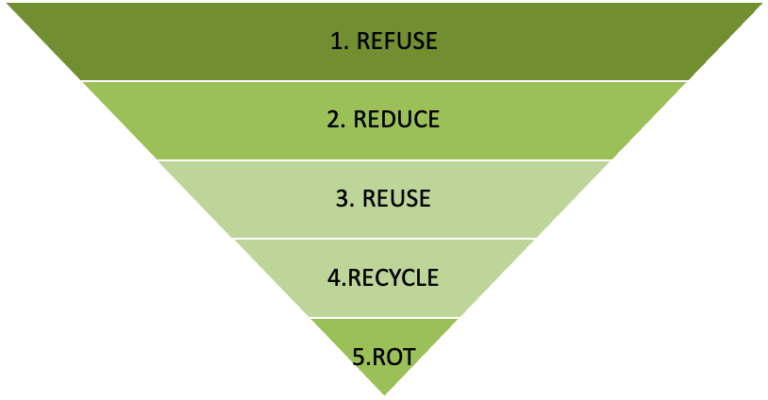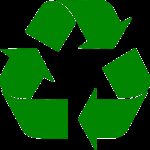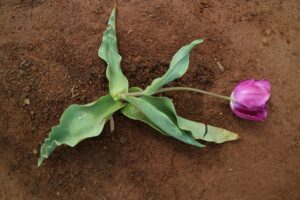Understanding the ‘R’s
There are so many ways to do your bit and start your green journey. If you ask me how to deeply engrave it in your brain’s hardwiring – the first place is to be aware of what your action is and what will its impact be. A great yardstick to judge the impact of your actions is to be aware of the 5Rs of sustainable living.
The 5Rs (coined by Bea Johnson, in the 2013 book Zero Waste Home) have been advocated for many years by environmentalists and zero waste living ambassadors. But it can be applied to literally all our consumer habits, hence I would start here.
In the below section, I will be explaining my take on the 5Rs but would also share with you 2 additional Rs, which I truly believe are key to embracing the 5Rs.
The 5 ‘R’s
The 5Rs are the following with their effectiveness decreasing from top to bottom. The more you go down the pyramid, the more energy and resources are used.

1. REFUSE
This is the most powerful and simplest thing you can do to decrease your carbon footprint. Try saying ’NO’ to things you don’t really need.
· Do you really need that plastic straw?
· Do you really need that one-time use party decoration?
· Do you really need to use those disposable plates for 5 people when you have washable plates at home?
· Can you walk to the place, instead of taking a bus?
Say ‘no’, rethink the need, and you are contributing to the environment for free. Yippee!!!

2. REDUCE
The second most effective way is to reduce the consumption of what we need. Just as above, you are trying to reduce your footprint, more consciously.
· Can you turn down the heater, if you are wearing warmer clothes
· Can you take public transport to work 2 days a week or try car-pooling?
· Can you switch off the unnecessary lighting?
· Can you reduce the number of ‘meat days’ in a week?

3. REUSE
This was the one your parents & grandparents were pros in and something we need to learn from them. This is one of the easiest but effective ways to do your bit, but sometimes forgotten in this new fast-paced, single-use culture around us.
· Do you really need a new dress for this party, or can you reuse an older one that is still in shape?
· Can you fix that radio player, instead of buying a new one?
· Is there a reusable cleaning cloth I can use here, instead of a one-time tissue?
· Check facebook market place or the nearby second hand shop, when you need to buy something, next time. Let us give some more love to ‘pre-loved’ items and make re-using in vogue again.

4. RECYCLE
Thank god for recycling, we have a solution to all the bottles, cans, and plastic bottles the world is throwing at us every single day. But recycling in itself does take energy and resources and unfortunately, many materials cannot be recycled and end up in landfills and the oceans. Hence this should be one of the last resorts.
Start asking the following questions about every item, before you throw them in the garbage?
· Can a part of this bottle be recycled?
· What material is this waste from and is my local recycling facility accepting these?
· If I clean or separate the tin cap from the glass bottle or the plastic coating removed, will the recyclability improve?
Recycling in itself is a complex topic with the type & extent of recyclability heavily dependent on local/ regional capacities and regulations and there is so much more as consumers we need to be aware of it and what the corporates are capable of changing. More on it in a later blog 😉

5. ROT
ROT refers to what you can do with the leftover food waste- Composting. When food waste ends up in landfills, they cause a bigger issue by creating methane gases, as unfortunately most landfills are not aerated. By composting food waste at home, we are not only diverting food waste ending up as greenhouse gas producers in landfills, but also producing homemade fertilizers. Does that not sound like a good plan?

My 2 additional ‘R’s
Now, are you ready for my own 2 Rs, which I believe are essential to convert the knowledge about the 5Rs into habits?
6. RESEARCH
Actively seek out information & knowledge about what you can do alternatively. There is so much information & small businesses out there, who are just waiting for you to join their customer base and join the revolution.
Will you not research, when you have to buy a new phone or television? In most cases, you would research on the internet for different options, to ensure you get the best value for money. Similarly, next time you are making a purchase, also try to think about the impact of that purchase. Researching and reading about the environmental impact of our actions gives us the power to make an informed choice to perform one of the Rs above, whenever possible. It also gives us the power to challenge and demand from the corporates and institutions who can actually make a bigger difference.
· Read and understand how waste is handled in your locality
· Is the brand you are using, committed to sustainability, or is it just a brand gimmick (greenwashing)?
· Is there a sustainable alternative available in the market to the single-use item you are using?
· Are there any local small businesses you can support, instead of shipping an order across the world?
7. RELEARN
I can’t stress enough the power of this one. Habits are so hard-wired in our brains that it sometimes is not easy to change. But don’t underestimate the power of our brain’s learning capacity. Try to challenge yourself to unlearn & relearn things
.
· The next time your hand reaches out to grab a plastic foil to cover your leftovers, think twice. Reach out for a stainless steel plate instead.
· The next time you are constructing/ buying housing, look at its energy rating and learn about its impact
· The next time you boil a whole kettle full of water for a cup of hot tea, use a thermal flask to store the rest of the warm water.
There are plenty of things we can do as an individual until the corporate giants offer us better alternatives and governments focus on stricter guidelines and grass root level activities. But let us keep the spirits high and do our bit. Remember that every bit counts and collectively our voices that demand better alternatives will be heard.
Follow GBH, as I will be deep diving into the topics above and sharing with you my learnings on the topics and alternatives.



Me also started thinking of the 7 Rs
So happy to hear that <3
7 rs ok. But 7 th one i am thinking about. Anything new we cannot accept fast.But as a brahmin i can proudly say so many among us now also reluctant to use plastic plate. They are more comfortable with plantain leaf. Also we are not using foils for keeping food especially being vegetarians and we prefer always steel vessels ,always. Stainless steel vessel is always a weakness of we people.So we will try for the green journey along with you.
Thank you so much aunty. Traditional methods are always the best. Plantain leaves, stainless steel etc are the most sustainable materials to use around food. It is a good reminder from you to keep using them 🙂
Very informative and practicable
Thank you!
Am delighted seeing you doing your part, in helping us all, simply make our planet earth a healthier better place for us and for the generations to come
Would definitely love to follow you in this journey ahead
I am so happy to have you join me in this journey! Thanks a lot 🙂
Much needed awareness.Thanks for sharing.Together we can make a difference..
Thanks a lot. Let us do this together 🙂
Great approaches to sustainable living! Well-written.
Thank you Divya. Great to see you here 🙂